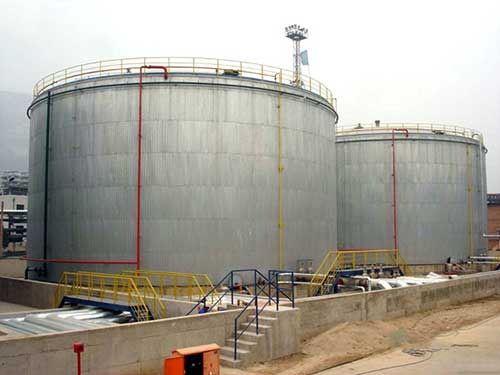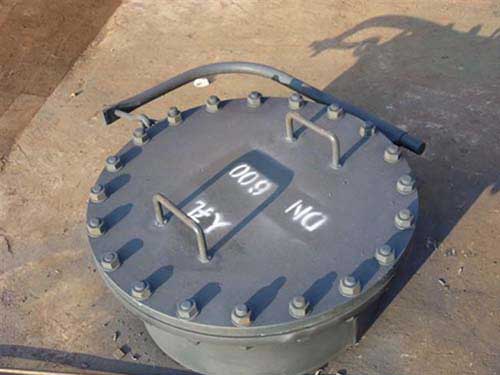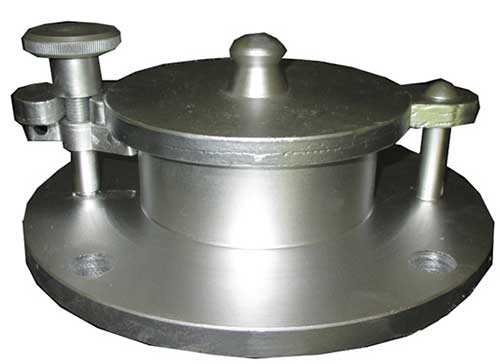What are the structural features of external floating roof tanks?
Structural features of the external floating roof tank
The upper part of the external floating roof tank is open, and the top cover is not arranged on the other. The roof of floating roof is in direct contact with the atmosphere. From the point of view of the structure design of the oil tank, the external floating roof tank is different from the other tanks. It is a problem that how to solve the problem of the stability of the tank wall under the action of wind load. In order to increase the stiffness of tank wall, in addition to the panel on the edge of a wrapping angle, away from the plate margin of about 1m and a wind ring. Wind ring is assembled by steel plate and steel combined section structure, its shape is round, can also be a polygon. For large oil tank, set one or more laps to ring in wind ring below, to prevent the tank wall wind ring following instability.

Accessory features of the external floating roof tank
In order to make it convenient for the management and maintenance of floating roof tank, the following is some accessories that are different from the attachment of the fixed roof tank.
Central drainage pipe. Floating roof of external floating roof tank directly exposure to the atmosphere, fall in the floating on top of rain and snow was not removed timely may cause floating roof sank. The central drainage pipe is arranged in order to discharge the rainwater collected on the floating roof in time. The upper is connected with central sump, the lower is connected to the outside of the tank drain valve. Floating on the top of the water is concentrated in the central sump, exhaust to the outside of a tank without oil pollution through the drainage tube. The central drainage pipe is composed of several sections of D IV 100mm which is immersed in the oil. Between the pipe and the pipe section is connected with a movable joint, with floating roof height of straight and bending, so called drainage folding tube. According to the size of the tank diameter, each tank can be provided with l~3 root drainage folding pipe.
Top of turn escalator is hanged on platform, so that it can be rotated around the hinge installed in the vicinity of the platform. The lower end of the float can be moved along the track on the floating roof with the floating roof lifting. The operator can work from the floating ladder to the floating roof. When the floating roof falls to the lowest position, the elevation of the rotating staircase shall be no more than 600.
There are 18 isolation of choking hole floating manhole, and 1 single disc manhole. The staff can get into the cabin to check for leaks through the manhole floating, or get into the tank by single disc manhole.

The valve is arranged on the floating roof, path diameter is 300mm. The effect is that the air in the tank is discharged when the floating roof is not floating to advance oil, or when the floating roof is supported on the oil tank to continue oil, the air is filled to the tank to prevent the vacuum from the top of the tank.
Emergency drain port is a backup safety device of drainage pipe. If the drainage fold tube failure, or when the floating roof rainwater accumulated in the upper, drainage tube cannot discharge in time, when the stockpile rainwater exceeds a certain height, can from emergency drainage tube row within the tank, lest floating boat sank.
The floating roof pillar is provided with 53 pipe support, and the circumferential distribution is arranged on the lower part of the floating roof, and the height of the floating roof upright column is generally adjustable in the range of 1.2~1.8m. On the one hand, this is to avoid the lower surface of the floating ship and the tank of the heating coil and other accessories collision. On the other hand is to maintenance support floating roof supporting height adjusted to 18m), in order to make the floating roof down to the lowest position with plenty of room for maintenance and cleaning.
There are totally two disc edges and the edge vent, which are respectively located on the edge of the single plate and the floating boat. The effect is to discharge the excess oil and gas from the bottom of the tank and the air filled with oil. Opening pressure is 12mm water column.
The operator measure the oil in the top of tank, at the same time, the floating roof plays a guiding role.



